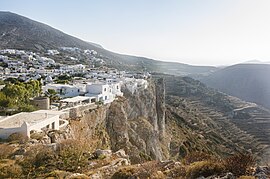Folegandros
Municipality in Greece From Wikipedia, the free encyclopedia
Folegandros (also Pholegandros; Greek: Φολέγανδρος) is a small Greek island in the Aegean Sea that, together with Sikinos, Ios, Anafi and Santorini, forms the southern part of the Cyclades. Its surface area is 32.216 square kilometres (12.439 sq mi)[2] and it has 719 inhabitants (2021). It has three small villages, Chora, Karavostasis, and Ano Meria, which are connected by a paved road. Folegandros is part of the Thira regional unit.[3]
Folegandros
Φολέγανδρος | |
|---|---|
Cliffs at Chora on Folegandros | |
| Coordinates: 36°37′N 24°54′E | |
| Country | Greece |
| Administrative region | South Aegean |
| Regional unit | Thira |
| Area | |
• Municipality | 32.216 km2 (12.439 sq mi) |
| Highest elevation | 455 m (1,493 ft) |
| Lowest elevation | 0 m (0 ft) |
| Population (2021)[1] | |
• Municipality | 719 |
| • Density | 22/km2 (58/sq mi) |
| • Community | 455 |
| Time zone | UTC+2 (EET) |
| • Summer (DST) | UTC+3 (EEST) |
| Postal code | 840 xx |
| Area code(s) | 22860 |
| Vehicle registration | EM |
| Website | www.folegandros.gr |
Mythology
According to Greek mythology, it was said to have derived its name from a son of Minos.[4]
History
Little is known about the ancient history of Folegandros. Its inhabitants were Dorians. Later it came under Athenian rule. The island contained a polis (city-state) called Pholegandros, which was sited at the modern Chora and a member of the Delian League, as which it appears on Athenian tribute lists between 425/4 and 416/15 BCE.[5] The island was called the iron Pholegandros by Aratus on account of its ruggedness, and is also noted by ancient geographers Strabo[6] and Ptolemy, who calls it Pholekandros (Ancient Greek: Φολέκανδρος).[7]
The island was conquered in 1207 by the Venetian Marco Sanudo and remained under the rule of Venice until 1566, when it was taken by the Ottoman Turks.
The Greeks reclaimed it in the 19th century during the Greek war of independence. The island was visited by the British explorers Theodore and Mabel Bent in early 1884.[8]
During the 20th century it has been used as a place of exile for political prisoners, especially during the 4th of August regime. [9]
Geography
Folegandros' landscape is varied, and includes tall cliffs and a large cave. The "capital" of the island, Chora, is built on the edge of a 200-metre high cliff. The port of Folegandros is the small village of Karavostasis. The Ano Meria village contains a small but interesting Ecological and Folklore Museum. Among the notable beaches on Folegandros is Katergo, accessible only by foot or by boat from Karavostasis. Katergo beach is used by naturists.[10]
Gallery
- View of Chora
- Chora seen from the church of Panagia
- House of the island
- Inside the "Kastro" of Chora
- Chora
- Chora & the church o Panagia to the north
- Ano Meria
References
External links
Wikiwand - on
Seamless Wikipedia browsing. On steroids.















